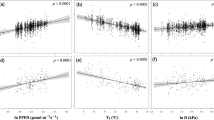Abstract
The objectives of this synthesis are (1) to review the factors that influence the ecological, geographical, and palaeoecological distributions of plants possessing C4 photosynthesis and (2) to propose a hypothesis/model to explain both the distribution of C4 plants with respect to temperature and CO2 and why C4 photosynthesis is relatively uncommon in dicotyledonous plants (hereafter dicots), especially in comparison with its widespread distribution in monocotyledonous species (hereafter monocots). Our goal is to stimulate discussion of the factors controlling distributions of C4 plants today, historically, and under future elevated CO2 environments. Understanding the distributions of C3/C4 plants impacts not only primary productivity, but also the distribution, evolution, and migration of both invertebrates and vertebrates that graze on these plants. Sixteen separate studies all indicate that the current distributions of C4 monocots are tightly correlated with temperature: elevated temperatures during the growing season favor C4 monocots. In contrast, the seven studies on C4 dicot distributions suggest that a different environmental parameter, such as aridity (combination of temperature and evaporative potential), more closely describes their distributions. Differences in the temperature dependence of the quantum yield for CO2 uptake (light-use efficiency) of C3 and C4 species relate well to observed plant distributions and light-use efficiency is the only mechanism that has been proposed to explain distributional differences in C3/C4 monocots. Modeling of C3 and C4 light-use efficiencies under different combinations of atmospheric CO2 and temperature predicts that C4-dominated ecosystems should not have expanded until atmospheric CO2 concentrations reached the lower levels that are thought to have existed beginning near the end of the Miocene. At that time, palaeocarbonate and fossil data indicate a simultaneous, global expansion of C4-dominated grasslands. The C4 monocots generally have a higher quantum yield than C4 dicots and it is proposed that leaf venation patterns play a role in increasing the light-use efficiency of most C4 monocots. The reduced quantum yield of most C4 dicots is consistent with their rarity, and it is suggested that C4 dicots may not have been selected until CO2 concentrations reached their lowest levels during glacial maxima in the Quaternary. Given the intrinsic light-use efficiency advantage of C4 monocots, C4 dicots may have been limited in their distributions to the warmest ecosystems, saline ecosystems, and/or to highly disturbed ecosystems. All C4 plants have a significant advantage over C3 plants under low atmospheric CO2 conditions and are predicted to have expanded significantly on a global scale during full-glacial periods, especially in tropical regions. Bog and lake sediment cores as well as pedogenic carbonates support the hypothesis that C4 ecosystems were more extensive during the last glacial maximum and then decreased in abundance following deglaciation as atmospheric CO2 levels increased.
Similar content being viewed by others
Author information
Authors and Affiliations
Additional information
Received: 12 February 1997 / Accepted: 20 June 1997
Rights and permissions
About this article
Cite this article
Ehleringer, J., Cerling, T. & Helliker, B. C4 photosynthesis, atmospheric CO2, and climate. Oecologia 112, 285–299 (1997). https://doi.org/10.1007/s004420050311
Issue Date:
DOI: https://doi.org/10.1007/s004420050311



